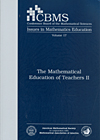- About MAA
- Membership
- MAA Publications
- Periodicals
- Blogs
- MAA Book Series
- MAA Press (an imprint of the AMS)
- MAA Notes
- MAA Reviews
- Mathematical Communication
- Information for Libraries
- Author Resources
- Advertise with MAA
- Meetings
- Competitions
- Programs
- Communities
- MAA Sections
- SIGMAA
- MAA Connect
- Students
- MAA Awards
- Awards Booklets
- Writing Awards
- Teaching Awards
- Service Awards
- Research Awards
- Lecture Awards
- Putnam Competition Individual and Team Winners
- D. E. Shaw Group AMC 8 Awards & Certificates
- Maryam Mirzakhani AMC 10 A Awards & Certificates
- Two Sigma AMC 10 B Awards & Certificates
- Jane Street AMC 12 A Awards & Certificates
- Akamai AMC 12 B Awards & Certificates
- High School Teachers
- News
You are here
The Mathematical Education of Teachers II

Publisher:
American Mathematical Society/Mathematical Association of America
Publication Date:
2012
Number of Pages:
86
Format:
Paperback
Series:
CBMS Issues in Mathematics Education 17
Price:
33.00
ISBN:
9780821869260
Category:
Report
The Basic Library List Committee suggests that undergraduate mathematics libraries consider this book for acquisition.
[Reviewed by , on ]
Christine Latulippe
06/20/2014
Published in 2012, The Mathematical Education of Teachers II (MET II) is Volume 17 in the Issues in Mathematics Education series from the Conference Board of the Mathematical Sciences (CBMS). This is a revision of the 2001 The Mathematical Education of Teachers (MET I), and includes current research, updated recommendations, and an overview of the Common Core State Standards for Mathematics (CCSSM, see Appendices B and C). Printed copies are available for purchase from the American Mathematical Society, and the entire report is freely available for download at the CBMS website.
Chapters 1 and 2 provide valuable research and background information about the school mathematics that has been taught and should be taught, current national standards (CCSSM), and traditions in mathematics departments and teacher education programs nationwide. Chapter 3 includes four recommendations for the mathematical education of teachers (updating those made in MET I) and two recommendations for the roles of mathematicians in teacher education.
Chapters 4, 5, and 6 contain elaborations on the coursework recommendations for the preparation of Elementary, Middle, and High School teachers, respectively. They outline what university coursework should look like in order to best prepare teachers of mathematics. Each chapter begins with a parallel list of questions, for example: “What mathematics should prospective middle grades teachers study to prepare for their careers? What kinds of coursework and programs will prepare middle grades teachers for teaching mathematics? What sorts of professional development experiences will develop and sustain high quality mathematics teaching in the middle grades? How can mathematicians make valuable contributions to these endeavors?” (p. 39). This list of questions is exactly what each chapter clearly outlines answers to and, in my opinion, a very clear overview of the value of this report.
Chapter 6, on recommendations for the preparation of High School Teachers, was especially eye-opening for me. A variety of coursework suggestions are provided to help departments help their students transition from high school mathematics to university level mathematics, and from doing university mathematics to teaching high school mathematics. Mathematicians and statisticians are urged to be more involved in the education of teachers, and attention is drawn to ways in which this can happen. The authors of MET II are realistic in their expectations, and statements like “…at many universities enrollments in teacher preparation programs are too low to create special courses” (p. 62) show that they recognize that creativity and open communication must be employed to improve the preparation of teachers of mathematics. Many of the example recommendations are mathematical topics I have never heard of, mathematical connections no one ever explained to me, or ideas I remember learning in exactly the discrete, disconnected way described in the text. The suggestions are well-justified, clearly explained, and inspire me to think “deeply about simple things” (Arnold Ross as cited on p. 62).
I am considering assigning portions of MET II to my pre-service teachers to read, for three main reasons. First, the opening chapters provide a rich summary of research and history related to the teaching of mathematics, written in an accessible style. Second, to use Chapter 4 as an example, for elementary teachers there are “illustrative activities” outlined which are worthy of reflection and ready for inclusion in mathematics content for elementary school teachers courses. Third, MET II is available free for download, and everyone has access to the content.
MET II is a book that I would like to see every professor of mathematics and statistics read. I did not have enough post-it notes to mark all of the thought-provoking passages, and intriguing research citations (the book’s detailed footnotes could almost necessitate a second reading). Throughout MET II, powerful ideas like “there is intellectual substance in school mathematics” (p. xii) are presented in a non-threatening and factual manner, promoting conversation among stakeholders in the education of teachers. There is something in this book for everyone connected to the teaching and learning of mathematics, including parents of school-aged children, K-12 administrators, and elementary math coaches. I highly recommend it.
Christine Latulippe is Associate Professor of Mathematics at Norwich University in Northfield, VT. Her primary focus is the preparation and professional development of mathematics teachers, but she enjoys any opportunity to help students better understand the beauty of mathematics.
See the table of contents in pdf format.
- Log in to post comments




